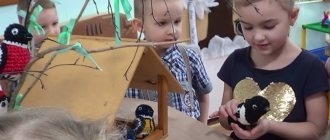Methods and techniques used in open classes to familiarize yourself with the environment in kindergarten
For an open lesson, the teacher should select only techniques that have been proven in practice - this is the main condition for a successful lesson. If we talk about work methods when studying a course on familiarization with the environment at a preschool educational institution, the list is quite extensive.
Visibility
Since this technique involves the active interaction of thinking, perception and speech, it is certainly considered one of the most productive and can be used in several forms.
Observation
A technique that allows one to identify essential features in phenomena and objects and establish cause-and-effect relationships between the objects being studied. In kindergarten, observation can be:
- short-term (for example, when children of the second youngest group monitor the speed of snow melting in a warm room);
- long-term (for example, children in the preparatory group watch the germination of beans every day).
Children enjoy participating in observations
One of the forms of implementing this technique is conducting experiments. Starting from the middle group (if the level of general development of the children allows, then from the second youngest), children participate in experimental activities.
There shouldn’t be a lot of experiments in the lesson, otherwise they will turn from an unusual and exciting type of work into an uninteresting routine.
Table: examples of experiments for open classes to get acquainted with the outside world
| Group | Lesson topic | Experience name | Goals | Description |
| Second youngest | Precipitation | "The ice is melting" | Introduce the property of water to freeze in the cold and thaw in the heat. |
|
| Average | Environmental pollution | “How soil pollution occurs” |
|
|
| Older | Wind | "Why does the wind appear" |
| Invite children to blow on a strip of paper lightly, strongly, moderately. Conclusion: if you blow strongly on a strip of paper, the air movement will be very fast, you will get a “breeze”, and if you blow lightly, the air movement will be weak, you will get a “breeze”. Wind is the movement of air. |
| Preparatory | Migratory birds | "Why do birds fly" |
| Children look at the birds that have flown to the site. Conversation with students.
|
Video: experimental activity in a lesson on familiarization with the outside world on the topic “Light and Shadow” in the junior group
Demonstration
Another option for using visibility, which is implemented in impressions:
- objects (plants, pictures of animals, agricultural tools, etc.);
- method of action (this technique is especially important when performing experiments - children perform all manipulations only after the teacher shows and explains each step of the experiment);
- pictures, presentations, educational videos, etc. (this is how the teacher introduces children to phenomena with which direct interaction is impossible, for example, the animal world of the Arctic).
Children also take part in demonstrations, presenting the results of their experiments, for example, water colored with food coloring
This is interesting. Taking into account the technological nature of our time, any demonstration using technical teaching aids (TST) makes the learning process more entertaining and attractive for children.
Verbal teaching techniques
This is an integral methodological component of working with children in kindergarten.
Conversation
Dialogue with children contributes to a stronger consolidation of acquired knowledge, and also develops the speech of little wards and expands their vocabulary. The conversation in younger groups takes the form of short answers to the teacher’s questions (for example, “What time of year is it now?”, “Month?”, “Weather?”), in older groups the answers become more detailed, and the wording of the questions has a problem-oriented focus (for example , “What do you know about the life of birds in winter?”).
Story
An effective technique for introducing new factual material. However, in an open lesson, you shouldn’t get too carried away with it: after all, the result of the work is assessed not by the teacher’s ability to tell an interesting story, but by the knowledge, skills and abilities that the students receive. Therefore, the story of children (in older groups) will be more advantageous.
Any practical actions in class are accompanied by verbal techniques
Reading
In older groups, if the kids already know how to read, during the lesson you can give the task to read short (1-2 simple sentences) notes about a particular phenomenon or object being studied. For example, when studying domestic animals, children can read about the benefits of each of them (“Cows give milk,” “Chickens lay eggs,” etc.).
Poems, riddles
This is a great motivational technique that gets kids ready to work. It fits especially well into the initial stage of the lesson as an update of basic knowledge. For example, when studying the topic “Autumn” in the middle group, children can be asked to solve riddles:
- Leaves fly off the branches, Birds fly away to the south. “What time of year?” we ask. They will answer us: “This is...” (Autumn).
- The wind will call the cloud, the cloud will float across the sky. And over the gardens and groves there is a cold drizzle... (Rain).
- In the gray sky low, clouds move close, covering the horizon. It will be raining. We took... (Umbrella).
- The clouds are gathering, Howling, blowing. Prowls the world, sings and whistles. (Wind).
This is interesting. In younger groups, it is better to choose riddles with endings - this makes it easier for the children to guess the answer.
As riddles, you can offer everyday situations, the solution to which will be one or another picture (for example, in the event of a fire, we call the fire department)
Many teachers choose a poem on the topic as an epigraph for a lesson. This technique not only helps children get involved in work faster, but also contributes to the development of children’s speech, since sounding rhyming lines teach children to correctly place stress in words and enrich their vocabulary. For example, when considering the topic “Wintering Birds” in a senior group, the selection could be like this:
- White grains are pouring into the garden, and the sparrows are flying to dinner. They sat down in a flock and began pecking... What kind of food they could not understand. This is not cereal, not cottage cheese, This is cold white snow.
- Here is a crow sitting on the fence. All the barns have been locked for a long time. All the convoys passed, all the carts. It's time for bad weather. She's fussing about on the fence. Woe to her. Real grief. After all, the crow doesn’t have a grain And there’s no defense against the cold...
- A magpie gallops through the spruce forest, hitting the snowstorm with its tail. It’s cold for a magpie to jump around without a fur coat. The magpie is crying, but there is nowhere to take it.
- Bullfinches on branches decorated with snow fringe. Ruddy apples grew in winter. Apples on an apple tree scurry merrily. Ice cream caterpillars are pecking at apples.
Fairy tales
A technique that is relevant for preschoolers of all ages. In an open lesson, its use not only perfectly motivates students to work, but also brings originality to the teacher’s methodological arsenal. It should be remembered that everything is good in moderation, so the fairy tale:
- must be on the topic (the legend about why bears fall asleep in winter will not be suitable for studying the topic of wintering birds - the roll call turns out to be too distant);
- differs in laconicism and simplicity.
Below we give an example of a fairy tale for children of senior preschool age (when studying the topic of different states of aggregation of water).
One day the bunny decided to run away from home. He ran far away, but still knew the way back. Then he sees a stream running. And the stream says to the little hare: “Let’s go and run a race.” Whoever runs to the forest faster wins.” The bunny agreed. So they ran to the forest.
They run, run, run, and then the bunny doesn’t see the stream and shouts: “Where are you, stream?” And the stream replies: “I evaporated and turned into fog. Well, let's run on. Where there is fog, there I am.” And they ran. They run, run, run, and then the bunny did not see the fog and shouted: “Where are you, stream that is fog?”
“I’m here,” says the stream, “I’ve turned into a cloud. Well, let’s run!”
The perplexed bunny and the stream continued on their way. They ran and ran, and then the bunny didn’t see the stream. The bunny shouts: “Where are you, stream, fog, cloud?” The brook replies: “I turned into rain. Well, let's run." And they ran, but suddenly the rain stopped, and again the bunny shouted: “Where are you, stream, fog, cloud, rain?” The brook replies: “I’m here, under your paws. The rain stopped, and I became a stream again.”
The stupid hare and the stream ran together to the forest. But the hare didn’t understand anything.
Mikhail Prishvin
https://nsportal.ru/detskiy-sad/okruzhayushchiy-mir/2014/01/29/skazki-o-vode
If the plot allows, then the fairy tale can be supplemented with a demonstration
Video: verbal techniques in a lesson on getting to know the outside world on the topic “Journey to the Land of Health”
Gaming techniques
Play is the leading activity of preschoolers. Particular attention should be paid to the use of games in the classroom, because this technique allows you to present information faster and better, practice it and consolidate it. That is why games can be used at all stages of the lesson. We are talking not only about didactic games, that is, those with an educational goal, but also about active games aimed at maintaining health. As for the latter, they are used as physical education minutes in the middle of the lesson.
Most children of any age enjoy playing with water.
Some experiments within the framework of observation in classes to get to know the outside world are of a playful nature, so methodologists do not recommend piling up similar techniques within one lesson.
Table: didactic games in an open lesson on getting to know the outside world for preschoolers of different ages
| Age | Name of the game (lesson topic) | Target | Description |
| Junior groups | “Collect a Picture” (“The City We Live in”) |
| We distribute envelopes with puzzles depicting a local landmark to the children in pairs. The kids’ task is to put together a picture (if there are not enough mini-groups, then the task can be completed at speed). |
| “Floats or Sinks” (“Properties of Water”) |
| We take toys from different materials, pieces of paper, etc., put them in the water and determine whether it sinks or floats. Then we divide all items into 2 categories. The task can be completed individually or in pairs. | |
| Average | “Find what I’ll show you” (“Vegetables, fruits”) | To consolidate children's knowledge about the names and appearance of vegetables and fruits. Note: the task can be complicated by adding models of exotic fruits. | We show for a short time one of the objects hidden under the napkin, remove it and give the task: “Find the same vegetable or fruit under another napkin and remember what it is called.” The kids work in turns until all the fruits and vegetables under the napkin are named. |
| “What kind of tree?” (“Flora world of the native land”) |
| The teacher describes a tree, children whose cards show 3-4 trees must name the one they are looking for. To make it more difficult, the game can be played against time. | |
| Senior groups | “Choose Right” (“Know Thyself”) | Form ideas about the structure of the human body. | Children choose from a set of toys the character that is most similar to a person, and explain their choice (there is a torso, arms, legs, etc.). |
| Interactive game “The Fourth Wheel” (“Insects”) | Teach children to unite representatives of the same class according to life cycle stages and external similarities. | The teacher shows the children slides with images of insects in different stages of development (butterfly, fly, ladybug and caterpillar). Students must find an extra object (a caterpillar, since the rest are adults). |



